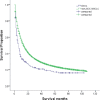Epidemiological features of lung giant cell carcinoma and therapy for patients with EGFR mutations based on case reports and the surveillance, epidemiology, and end results (SEER) database
- PMID: 28445978
- PMCID: PMC5421933
- DOI: 10.18632/oncotarget.15831
Epidemiological features of lung giant cell carcinoma and therapy for patients with EGFR mutations based on case reports and the surveillance, epidemiology, and end results (SEER) database
Abstract
Epidermal growth factor receptor-tyrosine kinase inhibitors (EGFR-TKIs) are the standard first line treatment for advanced non-small cell lung cancer (NSCLC) with sensitive EGFR mutations. Among NSCLC, giant cell carcinoma of the lung (GCCL) is a rare pathological subtype with poor prognosis, with no confirmed evidence about its epidemiological features or therapeutic efficiency of EGFR-TKIs. We present two advanced GCCLs with sensitive EGFR mutations, also collected the cases of GCCL from our hospital and the Surveillance, Epidemiology, and End Results (SEER) program. Kaplan-Meier methods and Cox proportional hazards modeling were used to perform the survival analyses. Both two cases of advanced GCCL with sensitive EGFR mutations benefited from EGFR-TKIs. Twelve GCCLs were recorded in our hospital from May 2006 to July 2015. GCCL is associated with males (83.3%) and smoking status (63.6%). The EGFR mutation rate was 40.0%. In SEER database, the total number of GCCLs was 184, 0.11% for all NSCLCs. In Kaplan-Meier analysis, the 5-year overall survival of GCCL patients was significantly lower than that of non-GCC NSCLC (16% and 19%; P<0.001), and it was confirmed in multivariate analysis. Further survival analyses indicated that male were more susceptible to GCCL and GCCL was prone to metastasize. Only age and M stage were independent prognostic factors for GCCL in the multivariate analysis. In conclusion, GCCL was an unfavorable prognostic factor and associated with males and metastasis. GCCL patients with sensitive EGFR mutations may also benefit from EGFR-TKI, we therefore recommend the evaluation of EGFR in the treatment of advanced GCCL.
Keywords: EGFR; EGFR-TKIs; lung giant cell carcinoma.
Conflict of interest statement
The authors disclose no potential conflicts of interest.
Figures





References
-
- Allemani C, Weir HK, Carreira H, Harewood R, Spika D, Wang XS, Bannon F, Ahn JV, Johnson CJ, Bonaventure A, Marcos-Gragera R, Stiller C, Silva GAE, et al. Global surveillance of cancer survival 1995-2009: analysis of individual data for 25 676 887 patients from 279 population-based registries in 67 countries (CONCORD-2) Lancet. 2015;385:977–1010. - PMC - PubMed
-
- Siegel RL, Miller KD, Jemal A. Cancer statistics, 2015. CA Cancer J Clin. 2015;65:5–29. - PubMed
-
- Sonnenblick A, de Azambuja E, Azim HA, Jr., Piccart M. An update on PARP inhibitors--moving to the adjuvant setting. Nat Rev Clin Oncol. 2015;12:27–41. - PubMed
-
- Maemondo M, Inoue A, Kobayashi K, Sugawara S, Oizumi S, Isobe H, Gemma A, Harada M, Yoshizawa H, Kinoshita I, Fujita Y, Okinaga S, Hirano H, et al. Gefitinib or chemotherapy for non-small-cell lung cancer with mutated EGFR. N Engl J Med. 2010;362:2380–2388. - PubMed
-
- Mitsudomi T, Morita S, Yatabe Y, Negoro S, Okamoto I, Tsurutani J, Seto T, Satouchi M, Tada H, Hirashima T, Asami K, Katakami N, Takada M, et al. Gefitinib versus cisplatin plus docetaxel in patients with non-small-cell lung cancer harbouring mutations of the epidermal growth factor receptor (WJTOG3405): an open label, randomised phase 3 trial. Lancet Oncol. 2010;11:121–128. - PubMed
Publication types
MeSH terms
Substances
LinkOut - more resources
Full Text Sources
Other Literature Sources
Medical
Molecular Biology Databases
Research Materials
Miscellaneous

